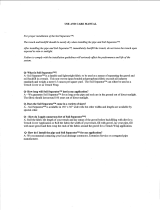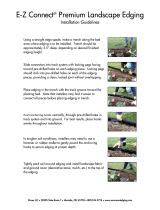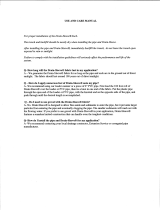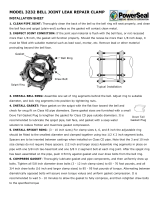
cORRUGATed plAsTic pipe
sTORm insTAllATiOn GUide
The MosT AdvAnced NaMe iN WaTer MaNageMeNT soluTioNs
TM

Introduction
Both corrugated high density polyethylene
(HDPE) and polypropylene (PP) pipes are
available for a variety of applications. These
applications include gravity flow storm and
sanitary sewer, low head pressure applications
as well as many others as deemed appropriate
by the design engineer. This installation pocket
guide is intended to provide guidance on typical
installation requirements for ADS plastic pipe
used for storm drainage. Product specific
exception to this pocket guide in the area of
acceptable backfill, fill heights, joint connections
and other product specific information may be
found by referencing the appendix for additional
resources.

Job Site Handling and Receiving ............... 5
Job Site Pipe Storage .................................. 7
Trench Construction .................................... 8
Trench Boxes ............................................... 10
Bell & Spigot Joint Assembly .................... 12
• Bar & Block Method ............................... 13
• Backhoe Method .................................... 14
• Backhoe and Sling Method .................... 14
Installation Stub Fabrication ...................... 15
Joining Different Pipe Types
or Sizes ......................................................... 16
Manholes and Catch Basin/
Connections ................................................. 17
Field Gasket Assembly ............................... 19
Fittings Assembly ........................................ 20
Backfill Recommendations ........................ 22
• Backfill Material Selection ...................... 22
• Groundwater or Surface Runoff ............. 24
• Backfill Envelope Construction ............... 24
Table of Contents

4
Other Installation Considerations .............. 25
• Construction and Paving Traffic ............. 26
• Maximum Cover ..................................... 27
• Vertical Installations ............................... 29
• Flotation .................................................. 30
• Bending Radius ...................................... 32
Repair Methods ........................................... 32
• Soil-tight:
– Option 1: Split Band Coupler .............. 32
– Option 2: Concrete Collar ................... 33
– Option 3: Mastic Banding .................... 33
• Watertight:
– Option 1: PVC Slip Coupling ............... 34
– Option 2: Concrete Collar.................... 34
– Option 3: Chemical Grouting............... 35
– Option 4: Internal Sealing ................... 35
Recommendations for
In-Field Testing ............................................ 36
• Leakage Testing ..................................... 36
• Deflection Testing ................................... 36
Appendix ...................................................... 38
Table of Contents

5
Job Site Handling and Receiving
Receiving Recommendations
Our distributors and customer service personnel
make service and customer satisfaction their
highest priority. If your order is incorrect,
contact your distributor or our customer service
personnel.
• Direct driver to a smooth, flat
area, free of rocks and debris.
• Examine load quantities
and quality immediately
after unloading. Inspect
pipe carefully for possible
damage from transportation or
unloading.
• Note damaged or missing
items on delivery receipt.
• Shortages and damaged material are not
automatically reshipped. Reorder replacement
material.
• Do not dispose of damaged items. Check
with driver for proper return method. If driver
is unsure, contact our customer service
personnel.
Handling Recommendations
To avoid damage to the pipe and fittings the
following handling recommendations should be
followed:
• OSHA safety requirements.
• Do not drop pipe.
• Avoid any impact to the bell or spigot.
• 18" (450mm) and smaller pipe can be moved
by hand. Larger pipe requires a backhoe with
a nylon sling.

6
• Lift 36" (900mm) and larger diameter pipe with
a sling at two points, spaced approximately
10 feet (3m) apart. Smaller diameters
can use one lift point. Refer to Table 1 for
recommended handling methods.
Table 1:
* Recommended handling methods are based on two laborers per pipe length,
neither of which is carrying more than 100 lb. (45kg).
≤18" (450mm)
24"-30" (600-750mm) ≥36" (900mm)
• Contractor assistance is required to unload
palletized pipe.
• Do not use a loading boom or forklift directly
on or inside pipe.
Recommended Handling Method for Pipe
Diameter
HDPE Approx.
Handling
in. (mm)
lb/ft (kg/m)
HP DW Approx.
lb/ft (kg/m)
Method*
4 (100) Labor
6 (150) Labor
8 (200) Labor
10 (250) Labor
12 (300) Labor
15 (375) Labor
18 (450) Labor
24 (600) Sling (1 point)
30 (750) Sling (1 point)
36 (900) Sling (2 points)
42 (1050) Sling (2 points)
48 (1200) Sling (2 points)
54 (1350) Sling (2 points)
60 (1500) Sling (2 points)
0.44 (.65)
0.85 (1.3)
1.5 (2.2)
2.1 (3.1)
3.2 (4.8)
4.6 (6.9)
6.4 (9.6)
11.0 (16.4)
15.2 (22.6)
19.8 (29.5)
24.3 (36.1)
30.9 (45.9)
36.5 (54.0)
44.5 (66.3)
n/a
n/a
n/a
n/a
n/a
3.6 (5.4)
5.3 (7.9)
7.1 (10.5)
11.9 (17.7)
16.8 (24.9)
20.3 (30.2)
24.3 (36.1)
32.4 (48.2)
49.6 (73.8)

7
Job Site Pipe Storage
Storage Recommendations
To ensure that your delivered pipe products do
not become damaged during job site storage,
follow these simple guidelines:
• Non-palletized pipe may be temporarily
stockpiled on a flat, clear area.
• Use securing timbers (or blocks) to ensure the
stockpile does not collapse.
• Failure to block pipe may result in stack
collapsing, pipe damage, or personal injury.
• Stack pipe no higher than
approximately 6 feet (1.8m).
• While supporting lengths of
pipe evenly, alternate bells
for each row of pipe.
• To prevent damage to the bell
or spigot when moving pipe
sections, do not drag or strike
pipe ends against anything.

8
Trench Construction
Table 2:
Minimum Trench Widths
Pipe Diameter in. (mm) Trench Width in. (m)
4 - 8 (100 - 200) *
10 (250) 28 (0.7)
12 (300) 30 (0.8)
15 (375) 34 (0.9)
18 (450) 39 (1.0)
24 (600) 48 (1.2)
30 (750) 56 (1.4)
36 (900) 64 (1.6)
42 (1050) 72 (1.8)
48 (1200) 80 (2.0)
54 (1350) 88 (2.2)
60 (1500) 96 (2.4)
*Usually dependent on smallest bucket size available.
• Information provided in this pocket installation
guide is intended as a quick reference
only and does not supersede requirements
specified on project plans.
• The trench or ditch should
be wide enough to place and
compact backfill around the
entire pipe.
• Refer to Table 2 for
recommended minimum trench widths. The
design engineer may modify the trench width
based on site specific conditions.
See table
• For parallel pipe installations, allow space
between pipes for proper compaction. Refer to
Figure 1 for minimum pipe spacing.
*Spacing will differ for retention/detention
systems due to the intended use of this
product.

9
• Trench or ditch bottoms containing bedrock,
soft muck or refuse, or other material unable
to provide long-term uniform pipe support are
unacceptable.
• All unsuitable foundation shall
be excavated before pipe
installation proceeds.
• Where the trench bottom is
unstable, the contractor shall
excavate to a depth required
by the engineer and replace
with suitable material as is
specified by the engineer.
• If native soil can migrate into
backfill, use synthetic fabric
(geotextile) to separate native
soil from backfill.
Figure 1: Parallel Pipe Installation
UP TO 24" (600MM) I.D.: M=12" (300MM)
MORE THAN 24" (600MM) I.D.: M=1/2 I.D.
Good foundation
needed
Quality
backfill
Minimum
cover

10
Trench boxes provide a safe work area to
install pipe in deep trenches or in soils that
have insufficient stability. Always follow OSHA
requirements when using a trench box.
The length of the trench box should be suitable
for the pipe length. Nominal length for pipe is
20 ft. (6.1m) although shorter lengths can be
supplied.
The most effective way to maintain a sound system
is to provide a ‘subtrench’ within which to place
the pipe and backfill. The subtrench shall not be
greater than 24" above the bottom on the trench as
shown in Figure 2. Backfill and compact according
to the design specifications within the subtrench.
The trench box can be pulled along the top edge
of the subtrench without affecting the backfill in the
pipe embedment zone.
Trench Boxes

11
Figure 2: Subtrench Installation
TRENCH BOX
BACKFILL
DUMPED
OVER PIPE
MATERIAL AND COMPACTION
LEVEL PER PROJECT
SPECIFICATIONS
MINIMUM TRENCH WIDTH
12” MINIMUM
24” MAX.
SUBTRENCH
BEDDING
In installations not involving a subtrench,
dragging a trench box should only be done if it
does not damage the pipe or disrupt the backfill;
otherwise, the box should be lifted vertically into
its new position, again taking great care not to
disturb the pipe or backfill.

12
For pipe with a bell-and-spigot connection, it is
imperative that the joint be assembled properly to
ensure that the product performs to expectations.
The steps that must be followed to obtain a
quality joint are provided below. Failure to follow
these instructions may cause the joint quality to
be severely compromised.
• Lower pipe into trench by hand, or use nylon
straps and excavating equipment.
• Begin by inspecting the bell and remove any
foreign matter.
• Use a clean rag or brush to
lubricate bell of pipe lubricant.
• Clean spigot end of pipe.
• Remove protective wrap
from gasket.
• Using clean rag or brush,
lubricate exposed gasket with
pipe lubricant.
• Do not allow lubricated
section to touch dirt or backfill.
Foreign matter could adhere
to surface and compromise
joint integrity.
• Place spigot into bell and
align.
Note: It is recommended that one always
lay pipe starting at the down stream end,
pushing spigots into bells with the bells facing
upstream. Always push spigot ends into bell,
not bell end into spigot.
Bell & Spigot Joint Assembly

13
Assemble joint using one of the following
methods. (For smaller diameters, pipe may be
joined manually.)
• For all methods, ensure bell and spigot are
adequately “homed” for proper installation and
tight joining seal. If no homing mark is present,
measure the depth of the bell and
use a crayon or other material to place a
homing mark on appropriate corrugation of the
spigot end. Care should be taken to not over
home the pipe during assembly.
• Installation stubs, mentioned in the assembly
instructions, can be purchased or made
following the information on page 15.
• Some high joint performance applications may
require the joint to be held in place for a short
time, immediately after insertion, to properly
set the gasket.
• Place installation stub into bell end of pipe.
• Place wooden block horizontally across end of
installation stub.
• With a bar, push against wooden block until
pipe is fully inserted into bell.
Bar & Block Method
NOTE: This method requires use of installation stub. DO
NOT push directly against pipe.

14
• Place installation stub into bell end of pipe.
• Place
wooden
block
horizontally
across
installation
stub.
• Carefully push
back of backhoe bucket against block until
pipe is fully inserted into bell.
Backhoe Method
NOTE: This method requires use of installation stub. DO
NOT push backhoe directly against pipe.
• Wrap nylon sling around pipe. Pipe 36"
(900mm) or larger should be picked up at two
points approximately 10' (3m) apart.
• Hook other
end of
nylon sling
to backhoe
bucket.
• Operator
should
carefully push
strap tight
toward bell of downstream pipe until spigot is
fully inserted into bell.
• Ensure pipe slides squarely into bell to avoid
misalignment.
• Keep pipe level.
Backhoe and Sling Method
NOTE: Distance from bedding to bottom of pipe not to
exceed 6" (150mm) for a 20' (6m) pipe.

15
Installation Stub Fabrication
To push “home” bell-and-spigot
pipe, an installation stub can
be used to prevent accidental
damage to the bell. Installation
stubs are not required if the bell
is not pushed on directly. Installation stubs in all
sizes are available from your distributor, or you
can fabricate your own on site by following the
proceeding steps:
• Cut a section of pipe five corrugations long in
the center of the corrugation valley.
• Using a saw, remove a strip of pipe wall from
the short stub of pipe (Figure 3). Note: Strip
width depends on pipe size. See Table 3 for
recommended widths.
Figure 3: Installation Stub

16
Table 3:
Strip Width for Installation Stub
Diameter in. (mm) Width in. (mm)
4-6 (100-150) 2 (51)
8 (200) 2.5 (64)
10-12 (250-300) 4 (102)
15 (375) 5 (127)
18 (450) 6 (152)
24 (600) 7.5 (191)
30-42 (750-1050) 10 (254)
48-60 (1200-1500) 12 (305)
• To use stub, push on pipe walls to change
O.D. of stub to I.D. of bell to be installed.
Joining Different Pipe Types or Sizes
Drainage systems often involve
connecting pipes of different
materials or sizes. Options
to make these transitions
are often limited by the joint
quality required. One very common method of
connecting different types of pipe of the same
size, and in some cases different sizes, is through
the use of a concrete collar. This generally
provides a minimum silt-tight joint quality but
the resulting quality ultimately depends on
workmanship.
Concrete
collar
Geotextile

17
• A concrete collar is formed by butting the
two pipe ends tightly together, wrapping the
junction with a geotextile to keep out most soil
and concrete, and then pouring a concrete
collar that covers both pipe ends.
Another option may be using fittings or adapters
specifically designed for this application. A
selection of fittings designed to make the
transition from one material directly to another is
available. In other cases a fitting may need to be
used in combination with another manufacturer’s
gasket or coupler to complete the transition.
Transitions made in this manner may provide for a
higher performance joint than a concrete collar.
Manholes and Catch Basin/Connections
Manholes or catch basins can be used at
changes in pipe material, size, grade, direction
and elevation. Manholes and catch basins can
be more costly than other alter natives but also
allow grade and directional changes in addition to
changes in pipe material and size.
• Local regulations should be consulted to
determine if manholes or catch basins are
required at any or all pipe changes.
• Refer to Figure 4 for the acceptable methods
of connecting plastic pipe to manholes or
basins.
• See appendix for references to additional
product specific resources applicable to
connecting pipe to manholes.

18
Figure 4:
WATERTIGHT
CONNECTOR
(KOR-N-SEAL
® II
OR KOR-N-SEAL 306)
PVC MANHOLE
ADAPTER
TYPE 2
WATERTIGHT
USING PRE-FABRICAT ED
ADAPTER
TYPE 1
WATERTIGHT
USING PRE-FABRICATED
ADAPTER
TYPE 3
WATERTIGHT
USING PVC
MANHOLE ADAPTER
PRE-FABRICATED
MANHOLE ADAPTER
WATERTIGHT
CONNECTOR
(A-LOK
®)
WATERTIGHT
CONNECTOR
(KOR-N-SEAL II
OR KOR-N-SEAL 306)
WATERTIGHT
CONNECTOR
(Z-LOK)
DUAL WALL
N-12 HP PIPE
TYPE 4
WATERTIGHT
USING MECHANICAL
CONNECTOR
Product Detail for Manhole Connections

19
WATERTIGHT
CONNECTOR
(KOR-N-SEAL
® II
OR KOR-N-SEAL 306)
PVC MANHOLE
ADAPTER
TYPE 2
WATERTIGHT
USING PRE-FABRICAT ED
ADAPTER
TYPE 1
WATERTIGHT
USING PRE-FABRICATED
ADAPTER
TYPE 3
WATERTIGHT
USING PVC
MANHOLE ADAPTER
PRE-FABRICATED
MANHOLE ADAPTER
WATERTIGHT
CONNECTOR
(A-LOK
®)
WATERTIGHT
CONNECTOR
(KOR-N-SEAL II
OR KOR-N-SEAL 306)
WATERTIGHT
CONNECTOR
(Z-LOK)
DUAL WALL
N-12 HP PIPE
TYPE 4
WATERTIGHT
USING MECHANICAL
CONNECTOR
When standard lengths of pipe must be cut to fit
in a field application, the following instructions will
ensure proper performing joints:
• For reduced spigot pipe
ONLY, reducing spigot must
be removed.
• Using a saw, cut in the center
of the valley of the first full
corrugation.
• Trim remaining plastic burrs from saw cut.
Note: Failure to smoothly trim burrs may
compromise joint integrity.
• Wipe clean first valley from end of pipe.
This is where gasket will be placed.
• Hold gasket with both hands so printing is
facing you.
• With printing on gasket face-up and toward
spigot end of pipe, slide gasket into first
corrugation valley, starting at bottom. Note: It
is easier to pull gasket up to conform to valley.
• Slide gasket into first corrugation valley by
hand.
• Ensure printing on gasket is face-up and
toward spigot end of pipe.
• Vent tubes shall be appropriately scaled at
joint where applicable, see Technical Note
5.10: Integral Bell Transition for HDPE.
Field Gasket Assembly
1 2 3 4
Gasket printing
should be visible
in this location
when properly
installed.

20
Fittings Assembly
This section includes information necessary for:
1. Soil-tight belled fittings
2. Watertight fittings
3. Repair couplers
• Cut pipe to desired length in the center of the
corrugation valley before placing in trench.
• Trim remaining polyethylene burrs from saw
cut. Note: Failure to smoothly trim burrs may
compromise joint integrity.
• Excavate bedding from around spigot end
where fitting shall be used. A bell hole will help
prevent dirt and debris from contaminating
joint during assembly.
• Install gasket in accordance with gasket
assembly procedure (page 19).
• Measure the depth of the bell and use a
crayon or other material to place a homing
mark on appropriate corrugation of the spigot
end.
• Vent tubes shall be appropriately sealed at
joint where applicable, see Technical Note
5.10: Integral Bell Transition for HDPE.
Page is loading ...
Page is loading ...
Page is loading ...
Page is loading ...
Page is loading ...
Page is loading ...
Page is loading ...
Page is loading ...
Page is loading ...
Page is loading ...
Page is loading ...
Page is loading ...
Page is loading ...
Page is loading ...
Page is loading ...
Page is loading ...
Page is loading ...
Page is loading ...
Page is loading ...
Page is loading ...
-
 1
1
-
 2
2
-
 3
3
-
 4
4
-
 5
5
-
 6
6
-
 7
7
-
 8
8
-
 9
9
-
 10
10
-
 11
11
-
 12
12
-
 13
13
-
 14
14
-
 15
15
-
 16
16
-
 17
17
-
 18
18
-
 19
19
-
 20
20
-
 21
21
-
 22
22
-
 23
23
-
 24
24
-
 25
25
-
 26
26
-
 27
27
-
 28
28
-
 29
29
-
 30
30
-
 31
31
-
 32
32
-
 33
33
-
 34
34
-
 35
35
-
 36
36
-
 37
37
-
 38
38
-
 39
39
-
 40
40
Advanced Drainage Systems 36650013IBPL1 Installation guide
- Type
- Installation guide
- This manual is also suitable for
Ask a question and I''ll find the answer in the document
Finding information in a document is now easier with AI
Related papers
Other documents
-
MYERS G30, WG50, WG30H, WG50H and WG75H Owner's manual
-
 Soil Separator 36150SSF-6 User manual
Soil Separator 36150SSF-6 User manual
-
Construction Metals FVW208-12 Operating instructions
-
Redi Base RDB1 Installation guide
-
Multi-Fittings Corporation 040206 Installation guide
-
 E-Z Connect 1981-RFLL Installation guide
E-Z Connect 1981-RFLL Installation guide
-
 Drain-Sleeve 03010-12 User manual
Drain-Sleeve 03010-12 User manual
-
 Powerseal Pipeline Products 3232080000HA Installation guide
Powerseal Pipeline Products 3232080000HA Installation guide
-
Multi-Fittings Corporation 040756 User guide
-
Fernco FSDP-GP3G Installation guide













































